So long, Roaratorio. Goodbye, Biped. Farewell, Second Hand. And Pond Way, Split Sides, Rainforest, it’s been great to know you. Pardon the tears. New Yorkers may see scraps from these works in the Merce Cunningham Dance Company’s Events at the Park Avenue Armory on the last days of 2011. Then silence and stillness. Or, as Cunningham’s longtime collaborator, composer John Cage, might remind us, a silence filled with the sounds of life going on and a stillness fraught with beautiful remembered motion.
As the two-year MCDC Legacy Tour that followed Cunningham’s death in 2009 winds down and the company ends its nearly 60-year existence, the dancers are performing with a quiet intensity that makes every moment luminous. In the three works that I saw during MCDC’s all-too-brief December season at the Brooklyn Academy of Music, company members brought to life Cunningham’s words about neither over-performing nor under-performing; in his eyes, “just do the movement” was a challenge to find fullness and proportion at each instant and to be alert to small shifts in the wind of the choreography.
Years ago, the critic Clive Barnes ventured the notion that without costumes and décor, all Cunningham dances would look alike. History has not allowed him to get away with that. It is true that there is a distinctive look about Cunningham’s movement. The dancers’ default posture is erect; when they bend or tilt or twist, they appear to do so by choice and not because inner agony or outer forces have them in thrall. They stretch their limbs and point their toes as adeptly as ballet dancers, but without the exalted manner and attention-getting preparations that often cloak steps in the classical lexicon. In contrast to many other styles of modern and postmodern dance, Cunningham dancing challenges the performers to step out quickly and intricately and to hold long, serene balances on one leg.
However, each work configures and alters the basic Cunningham look by means of choreographic choices and chance operations. The pacing alters; the texture becomes denser or more austere; the contacts between dancers assume varying degrees of complexity. The atmosphere may seem subtly sunny, playful, businesslike, sad, edged with danger; it’s up to us to assign “meanings” if we so wish.
Roaratorio (1983) is a friendly piece. When not busy, the dancers perch on or near bar stools, arranging them now and then to get a better view of the comings and goings. They wear bright-colored practice clothes and frequently appear with additional apparel, as if they’d just grabbed a tee shirt or a leg warmer from a backstage basket. Cage’s magnificent tape collage Roaratorio: An Irish Circus on Finnegans Wake swarms with life. In it, the River Liffey runs, waves break, dogs bark, babies cry, car horns blow, cocks crow, sheep bleat, church bells ring. Cage’s quiet voice (tinged with an Irish accent for the occasion) reads almost undecipherably from James Joyce’s masterwork, and scraps of tunes by pipes, fiddle, flute, bodhran, and a nasal-voiced folk singer further complicate the texture. Speakers placed around the theater embed us in this compendium of Irish-village sounds.
The dancing is lusty from the get-go. Cunningham uses no familiar Irish steps, but at times creates his own images of folk dancing. Dylan Crossman begins by showing us just how spraddle-legged, flex-footed, fast, springy, and vivacious it can get. The dancers don’t maintain an upright stance, but tilt from side to side or hunch over with the thrust of their feet. Jennifer Goggans tries out her version; so does Emma Desjardins. Rashaun Mitchell and Jamie Scott join. Krista Nelson dances by herself in this usually convivial place. Robert Swinston has an audience when he soloes. Then the couple-dancing starts, groups embark on mutually agreed-upon steps, form hand-in-hand chains, or bound in a circle. The vibrant Melissa Toogood, happy to be a part of this, teams up with some of the men for a brief, folksy fling. Brandon Collwes introduces a new step; it’s he who several times hoists Nelson and Andrea Weber out of the splits they keep sinking into. Daniel Madoff makes his feet stitch rapidly, while the others cluster and move slowly in their own individual ways. There are jokes. At one point (by now Silas Riener and John Hinrichs have arrived; later comes Marcie Munnerlyn) partners face each other and, holding hands, attempt a fast, tricky, low-kicking dance that nobody appears to know very well but which all of them doggedly carry on with anyway.
While Roaratorio leaves you grinning and thinking about skipping into the BAM lobby, Second Hand breaks your heart. When the latter premiered at BAM in 1970, it was explained that Cunningham—who usually treats musical scores as a parallel event to choreography rather than a supporting one—had expected to perform the piece to Erik Satie’s “symphonic drama” Socrate in Cage’s two-piano reduction of the score. When Satie’s estate denied the requisite permission, Cage quickly composed a new piano piece based on Satie’s structure and rhythms and called it Cheap Imitation. In response, Cunningham came up with the title of Second Hand. What the 1970 program did not mention was that the opening solo performed by the choreographer was a reconstruction of his 1944 Idyllic Song, which had been set to Cage’s two-piano reduction of the first part of Socrate (so in 1970, that too was secondhand, but in a different sense from Cage’s second authorial hand on the music). Nor did any program notes allude to the music’s three sections: “Portrait of Socrates,” “On the Banks of the Ilissus,” and “The Death of Socrates.”
Not for Cunningham the close dramatic (if abstracted) links made decades later by Mark Morris in his beautiful Socrate, set to Satie’s version for piano and sung text of translations from three of Plato’s Dialogues. Yet the exquisitely spare earlier dance is rich with implications. Who knows exactly why Cunningham chose to return to Satie’s score in 1969, the year he turned 50? Does it speak of the isolation of the artist from his disciples by virtue of the increasing age gap between him and them—a kind of death of the old company life? Whatever you make of Second Hand, it is elusively but ineffably tinged with sadness. And to perform it now—to watch it now— is akin to mourning.
In the opening solo, Robert Swinston never moves from a spot downstage center that is isolated from the surrounding darkness by Richard Nelson’s lighting. The single notes in Cage’s music, played by David Behrman, fall into pauses. The dancer is intent on his arms and what can be touched by a straight one reaching out and a curved one gathering in air. He treads in place, thrusts his hips from side to side or rocks from one foot to the other. A couple of times, he turns his head as if expecting someone to join him, but he retreats to the back of the stage when Andrea Weber arrives and watches her intently, occasionally making large, generous gestures in her direction. The text of Satie’s “On the Banks of the Ilissus” refers to a dialogue between Socrates and the younger Phaedrus. They discuss the nature of friendship and rest on the grass. Weber is dancing the role made for Carolyn Brown, who was, in 1970, the only remaining member of Cunningham’s original company—not only his most incandescent dancer, but one with an in-depth understanding of his work.
Weber is extraordinary in this part—strong, serene, owning the space even as she explores it. When she crosses the space with delicate little bounding hitch-kicks, her legs trailing behind her, she brings sunlight with her. She seems hardly to notice Swinston before she dances close to him and puts her hands on his shoulders. When they move together, they affirm something they both know, but he sits on the floor to watch while she jumps, as if lost in admiration for this marvelous colleague. In the end, they run circles around the stage, their arms around each other’s waists; at the end of the second circle, Weber just keeps going and disappears into the wings.
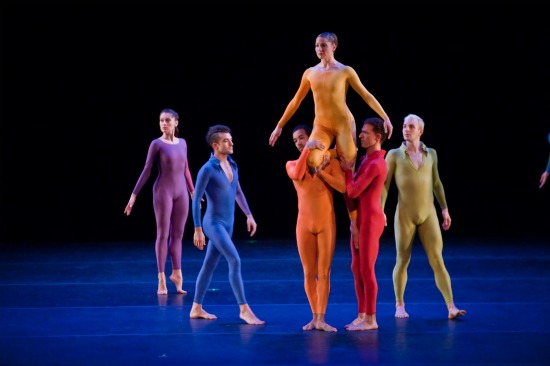
Andrea Weber aloft, with (left to right) Toogood, Riener, Mitchell, Madoff, and Collwes. Photo: Stephanie Berger
Gradually, unhurriedly, the other eight dancers enter with big, slow, smooth strides. Each wears a unitard of a different color. As your eyes graze the space, they encounter pockets of stillness that weave in and out of the silences in the music. Some people wait or pose while others gesture (Nelson spends a very long time with one leg in the air). Occasionally they lean on one another, or collaborate on an action, such as laying Weber gently down. In a hardly discernible fashion, they seem to trace a circle. Swinston may join them, and just before they leave, singly or in twos, they all face him. He’s left alone at the back of the stage, slowly lifting his arms and opening them.
The dancers’ exit seems like a leave-taking, and this is the section of Satie’s scenario in which Socrates’ friends come to say farewell and watch him drink the hemlock. Cunningham and some of his exegetes may deny that his subject was ever anything more than movement in time and space, but I doubt that. In Brown’s splendid book, Chance and Circumstance: Twenty Years with Cage and Cunningham, she writes that in the final stage rehearsal before the premiere of Second Hand, she’d been alarmed by the anguished expression on Cunningham’s face when they ran in the circles that ended their duet. She thought he might be exhausted or injured. The next day, Cage told her not to worry, “Merce said it’s at that moment that [Socrates] is preparing to meet death.”
Jasper Johns designed the costumes for Second Hand, dyeing the unitards so that one sleeve or leg of each shaded toward the nearest hue worn by someone else. That’s imperfectly rendered in the current costumes, but, still, when the performers line up for their curtain call, together they make a rainbow.
When Program B jumps from 1970 to 1999 and Biped, everyone is a rainbow. Suzanne Gallo’s body suits of various lengths shimmer like multi-colored moiré in Aaron Copp’s lighting, and the texture—both visual and aural—is dense and seductive. The year of Biped’s premiere, Cunningham turned 80 and ventured into new technological territory: motion capture. The décor by Shelley Eshkar and Paul Kaiser sometimes sets luminous virtual sticks tumbling above and around the live performers. Horizontal bars of light slide down as a fragmentary, occasional fence. Alignments of small white phantom balls that look like super-nimble dancers tumble by, while occasionally a ghostly one—immense or tiny— made of elegant chalk drawings imitates the steps you’ve seen executed by 12 flesh-and-blood dancers (Munnerlyn may be nursing an injury; she didn’t appear as scheduled in Second Hand or Biped). Meanwhile Copp alters the white-to-blue ratio of large light rectangles on the floor. Dancers appear out of the blackness at the rear of the stage and are engulfed by it again, as suddenly as the virtual images come to life.
Gavin Byars’ score for synthesizer, double bass, cello, violin, electric guitar, and percussion creates a strangely, fugitively romantic ambiance in which these shining creatures meet and mingle, dart like fish through dark waters, and disappear. Here the men spin; here five women move in slow harmony. Soloists swim into focus. Mitchell and Scott meet in a duet. And all the time Eshkar and Kaiser’s drifting world, visible to us and ignored by these gorgeous human bipeds, destabilizes their world—haunting them.
Speaking of virtual dancers, my computer uses some unfathomable chance procedure to deliver a different Imogen Cunningham photo to my screen every time I boot up. Usually it chooses Martha Graham. Yesterday, when I began writing this piece, the image was of Merce when he was a dancer in her company. He’s squatting, and only his knit-covered knees, his bent arms, and his pressed-together palms appear in the frame. He looks as if he’s about to launch himself into something—maybe a jump, maybe a career.
Cunningham’s inventiveness never flagged. He fed on risk. He was still discovering things about dancing and its theater when death brought him up short. Talk about haunting! Let’s hope that his adventurous spirit does just that to choreographers yet unborn.

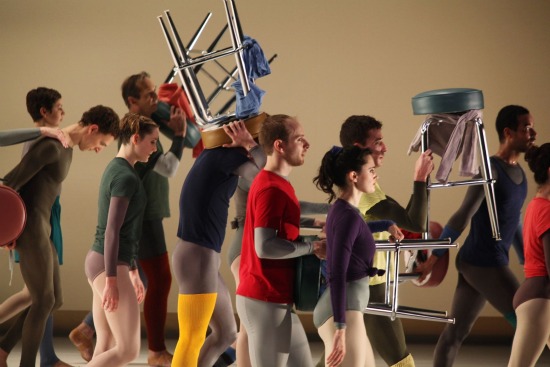
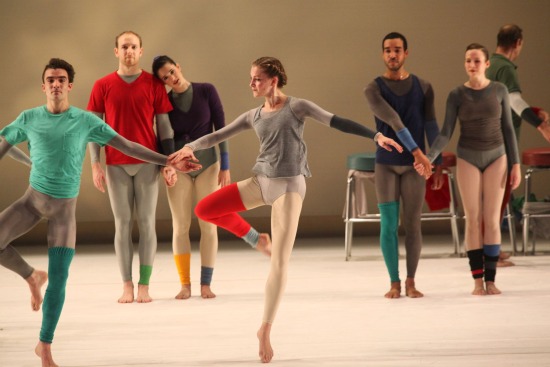
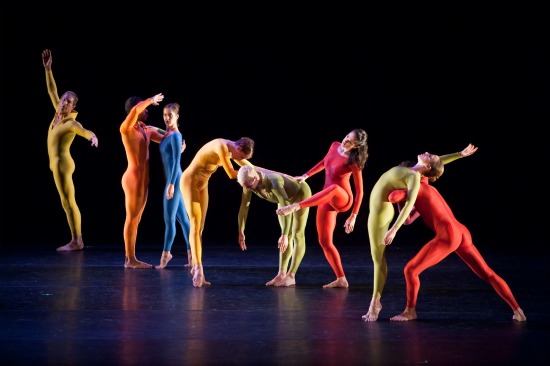
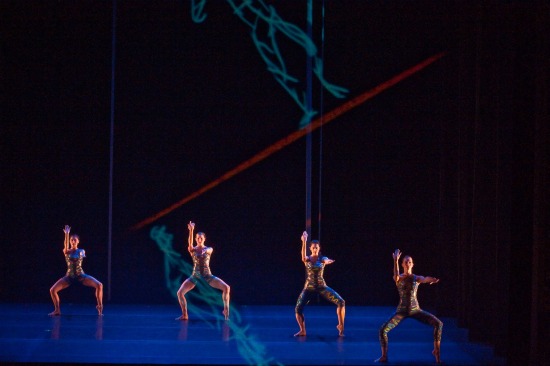
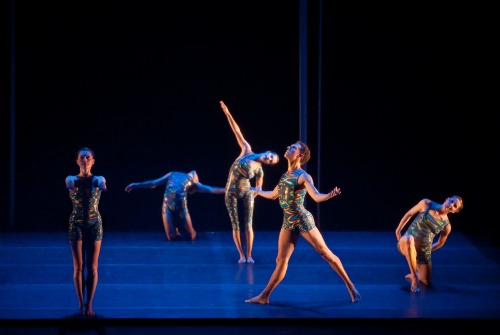
So beautiful, Deborah.
In 1971, James Klosty, editor-photographer of the book Merce Cunningham (1975), published an essay under the pseudonym of Michael Snell in Vol. 3, No. 6 of Ballet Review. Titled “Cunningham and the Critics,” it enlightened many as to the background of Second Hand, along with scoring points about the vagaries and misperceptions of critics in relation to Merce. Klosty’s article immediately raised my hackles, but ended up turning into a wake-up call.
Wonderful Deb!!
Amen, sistah! On many counts…
what a beautiful review/reflection/contextualization…
this is simply gorgeous.
sitting here thinking I have read so much about Cunningham’s work and aesthetic and now I find two sentences that capture his distinct style more eloquently than anything I have seen:
“…The dancers’ default posture is erect; when they bend or tilt or twist, they appear to do so by choice and not because inner agony or outer forces have them in thrall. They stretch their limbs and point their toes as adeptly as ballet dancers, but without the exalted manner and attention-getting preparations that often cloak steps in the classical lexicon…”
Thank you!!
Thanks Deborah — lovely to read. It’s the seagulls in Roaratorio that remind me most of Dublin…
Watching Second Hand on Thursday, I found it hard to believe that it had been 41 years since Jack and I saw the premiere in that same space, with the Cunningham aesthetic so wonderfully set of by the elaborate decoration of the BAM Opera House. Then we were thinking back to the premiere of Canfield the previous year, when for complicated reasons involving a union dispute there the Pauline Oliveros score wasn’t played, but the ambient sounds — cars, ambulances, dogs barking from the vet down the block — what you’ve so well called “a silence filled with the sounds of life going on.” These memories made more poignant the picture you’ve chosen to start this piece, as if the splendid Cunningham dancers had taken up their stools and are going off into the realm of memory— as they are indeed doing, to our lasting regret.